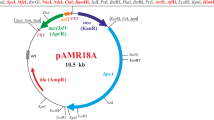Abstract
A plasmid, pBGFP, carrying green fluorescent protein (gfp) and benomyl-resistance genes was constructed and transformed into Metarhizium anisopliae. The transformants grew normally and GFP fluorescence was detected. No change was found in virulence for the transformants. Fluorescence was detected in hyphae from the haemolymph of the infected locust, and the benomyl-resistance was maintained. Results suggested that the two markers provided a useful tool for screening and monitoring the engineered strains even after infection.




Similar content being viewed by others
References
Aboul-Soud MA, Yun BW, Harrier LA et al (2004) Transformation of Fusarium oxysporum by particle bombardment and characterization of the resulting transformants expressing a GFP transgene. Mycopathologia 158:475–482
Bogo MR, Vainstein MH, Aragão FJL et al (1996) High frequency gene conversion among benomyl resistant transformants in the entomopathogenic fungus Metarhizium anisopliae. FEMS Microbiol Lett 142:123–127
Clarkson JM, Charnley AK (1996) New insights into the mechanisms of fungal pathogenesis in insects. Trends Microbiol 4:197–203
Cook RJ, Bruckart WL, Coulson JR et al (1996) Safety of microorganisms intended for pest and plant disease control: a framework for scientific evaluation. Biol Control 7:333–351
Cubitt AB, Heim R, Adams SR et al (1995) Understanding, improving and using green fluorescent proteins. Trends Biochem Sci 20:448–455
Feilmeier BJ, Iseminger G, Schroeder D et al (2000) Green fluorescent protein functions as a reporter for protein localization in Escherichia coli. J Bacteriol 182:4068–4076
Hu G, St. Leger RJ (2002) Field studies using a recombinant mycoinsecticide (Metarhizium anisopliae) reveal that it is rhizosphere competent. Appl Environ Microbiol 68:6383–6387
Inglis PW, Aragão FJL, Frazão H et al (2000) Biolistic co-transformation of Metarhizium anisopliae var. acridum strain CG423 with green fluorescent protein and resistance to glufosinate ammonium. FEMS Microbiol Lett 191:249–254
Li Z, Wang Z, Peng G, Yin Y et al (2006) Purification and characterization of a novel thermostable extracellular protein tyrosine phosphatase from Metarhizium anisopliae CQMa102. Biosci Biotechnol Biochem 78:1961–1968
Nakazato L, Dutra V, Broetto L et al (2006) Development of an expression vector for Metarhizium anisopliae based on the tef-1 alpha homologous promoter. Appl Microbiol Biotechnol 10:1–8
Punt PJ, Greaves PA, Kuyvenhoven A et al (1991) A twin-reporter vector for simultaneous analysis of expression signals of divergently transcribed, contiguous genes in filamentous fungi. Gene 104:119–122
Punt PJ, Zegers ND, Busscher M et al (1991) Intracellular and extracellular production of proteins in Aspergillus under the control of expression signals of the highly expressed Aspergilllus nidulans gpdA gene. J Biotechnol 17:19–33
Raeder U, Broda P (1985) Rapid preparation of DNA from filamentous fungi. Lett Appl Microbiol 1:17–20
Sambrook J, Fritsch EF, Maniatis T (1989) Molecular cloning. Cold Spring Harbor Laboratory Press, New York
St Leger RJ, Shimizu S, Joshi L et al (1995) Co-transformation of Metarhizium anisopliae by electroporation or using the gene gun to produce stable GUS transformants. FEMS Microbiol Lett 131:289–294
Thrane C, Lübeck M, Green H et al (1995) A tool for monitoring Trichoderma harzianum: I. Transformation with the GUS gene by protoplast technology. Phytopathology 85:1428–1435
Acknowledgements
The research was granted by the Natural Science Foundation of Chongqing Sci-tech Commission, P. R. China (NO. 8564 and 2006BB1141).
Author information
Authors and Affiliations
Corresponding author
Rights and permissions
About this article
Cite this article
Cao, Y., Peng, G., He, Z. et al. Transformation of Metarhizium anisopliae with benomyl resistance and green fluorescent protein genes provides a tag for genetically engineered strains. Biotechnol Lett 29, 907–911 (2007). https://doi.org/10.1007/s10529-007-9332-7
Received:
Revised:
Accepted:
Published:
Issue Date:
DOI: https://doi.org/10.1007/s10529-007-9332-7




